Iconic bridges crisscross the East River as it flows through New York City neighborhoods into Long Island Sound. The East River, a “tidal strait,” plays a critical role in the health of New York City’s economy and environment—and in particular, the health and future of Long Island Sound.
Save the Sound’s report, New York City Nitrogen Report: East River and Long Island Sound, details the connection between city residents and the Sound—highlighting recent successes and calling for new commitments to keep the Sound vibrant and productive today and for future generations.
View the NYC Nitrogen Report: East River and Long Island Sound
Nitrogen Pollution feeds hypoxic dead zones in Long Island Sound and the East River
For decades, excess nitrogen entering our coastal waterways devastated the health of Long Island Sound. The impacts are clear: low-oxygen waters and fish die offs, more algae blooms, murky waters, and loss of coastal marshes. Unacceptably low levels of oxygen in the waters, or hypoxia, occur every summer as a result of the high volumes of nitrogen entering the Sound from our communities—the equivalent by acre of what would be applied to agricultural farmland.
Nitrogen entering coastal waters originates from three sources:
- human sanitary waste from sewer and septic systems
- fertilizer applied to lawns, parks, and agricultural fields
- atmospheric deposition (rain, snow, and dust)
Across the entire Long Island Sound watershed each of these sources are significant nitrogen contributors, but they vary by community (subwatershed) depending on land use, density of the population and other factors. Almost all the nitrogen coming from New York City (the East River subwatershed) comes from the city’s sewer system—98%.
Sources of Nitrogen to the Sound (Adjusted)
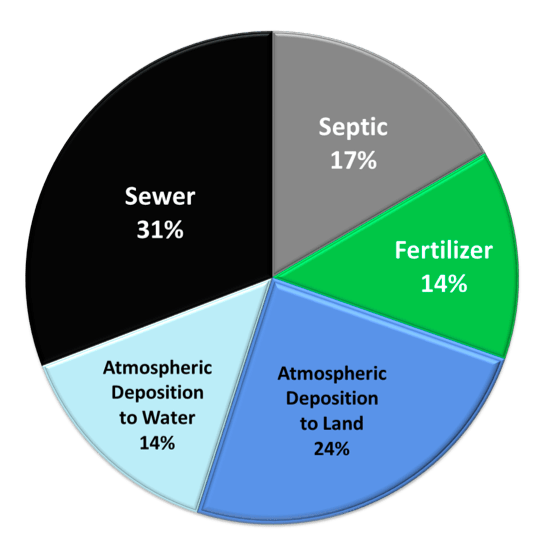
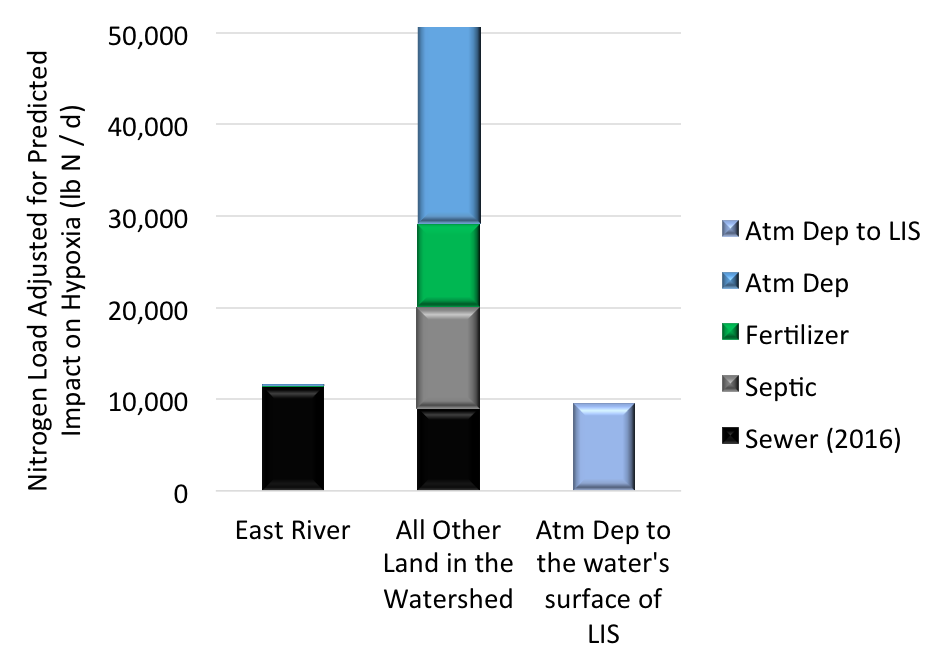
Of the approximately 9 million people living in the Long Island Sound watershed—which extends all the way to Canada—roughly 4 million are located in New York State at the very bottom of that watershed.
Sixty percent of the wastewater from the 8 million residents of New York City flows into the East River, which in turn flows into Long Island Sound. This gives the East River the outsized impact on Long Island Sound water quality shown in Figure 1.
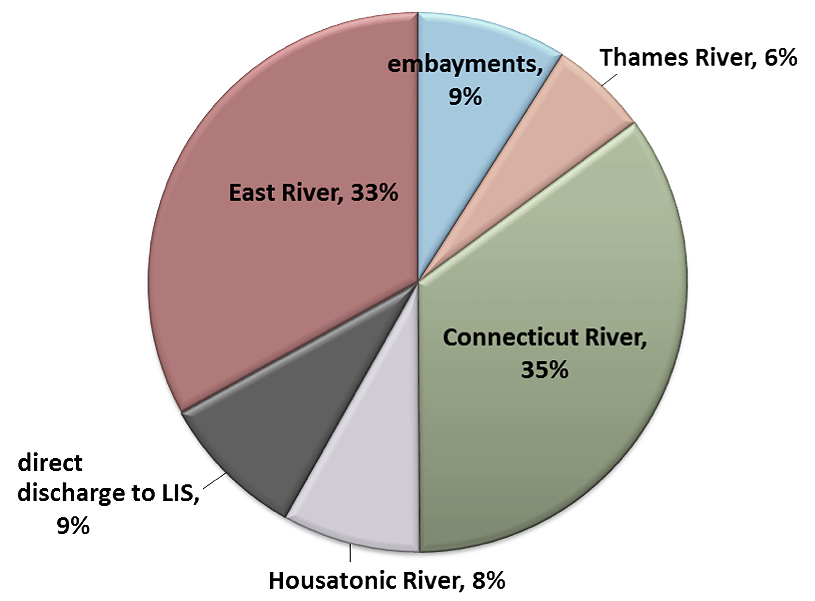
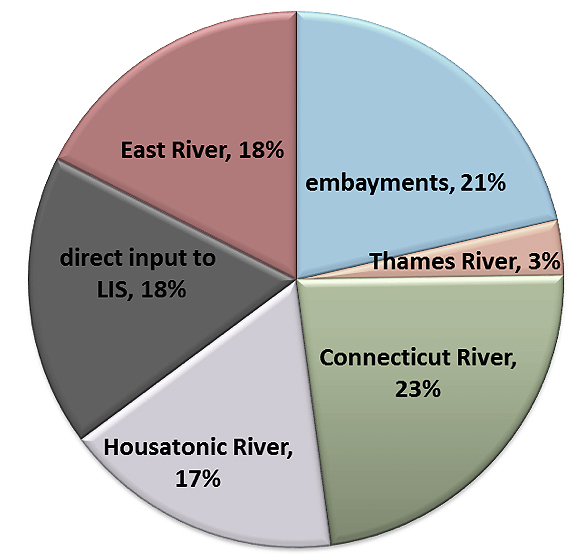
Figure 1: Sources of nitrogen shown by amount (top) and by their relative impact on water quality in Long Island Sound (bottom). Model & image credit: Dr. Jamie Vaudrey.
Progress reducing nitrogen
In 2001, New York State, New York City and the State Attorney General, made an agreement with EPA to reduce the combined nitrogen discharges from wastewater treatment plants located along the East River by 58.5% by 2015 (using 1990 levels as the baseline). Specifically, the plan called for four of the six New York City wastewater treatment plants that directly impact Long Island Sound—Hunts Point, Bowery Bay, Wards Island, and Tallman Island in the Upper East River—to be upgraded to treat nitrogen. The same pollution reduction commitment was made for wastewater plants that discharge to the Sound in Connecticut, Westchester County and on Long Island.
In 2016, after an approved extension, New York City met this target, reporting a 60% reduction in nitrogen coming from the East River into Long Island Sound.
Wastewater Treatment Plants & Daily Pounds of Nitrogen Discharge
The East River receives treated wastewater from six plants servicing the Bronx and portions of Manhattan, Queens, and Brooklyn. One of the two East River plants that did not receive the upgrades to treat nitrogen, Newtown Creek, contributes 44% of the nitrogen currently discharged to the East River. When adjusted for impact on Long Island Sound water quality, the Newtown Creek plant accounts for 30% of the remaining East River nitrogen.
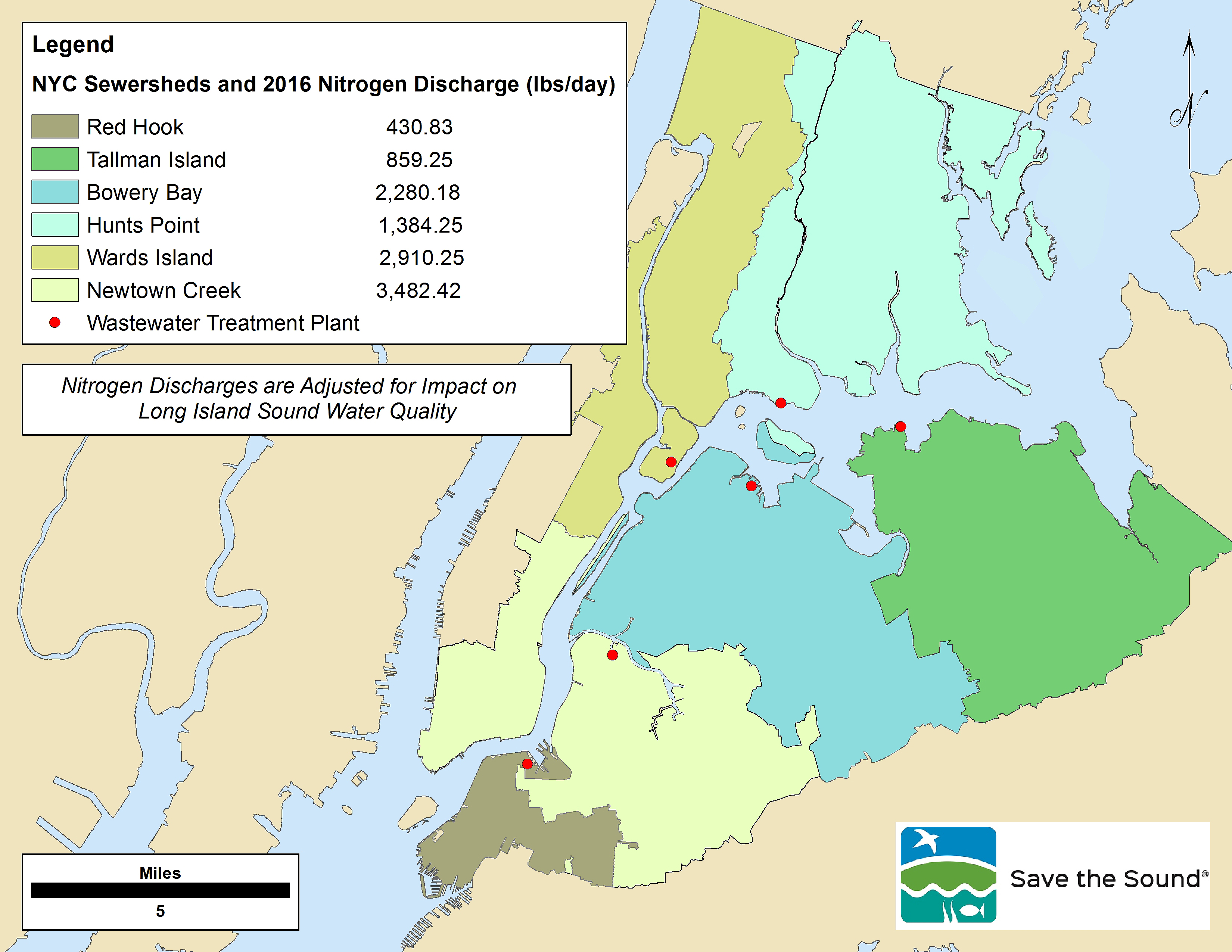
Daily Nitrogen Discharges: 1990 & 2016
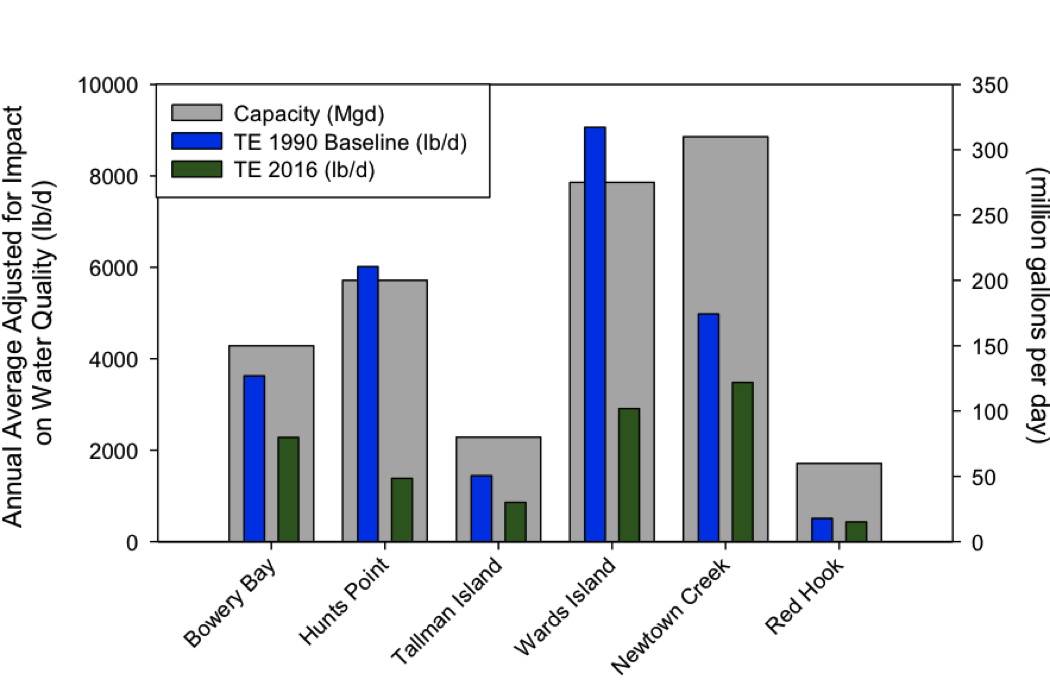
How’s the water?
For decades, unacceptably low levels of oxygen in the waters (hypoxia) occurs in the East River and the western end of Long Island Sound in the warmer summer months. Starting around 2015, wastewater treatment plants along the coastlines of Connecticut and New York have been completing upgrades to meet their shared goal of 58.5% reduction in nitrogen based on 1990 levels.
The good news is that the area of hypoxia in the Sound may have decreased by roughly half of what it was in 1987; we need a few more years of monitoring to confirm this decrease because the size of the hypoxic area varies year-to-year. Investments in upgrades to wastewater treatment plants over the last 20 years have driven this reduction.
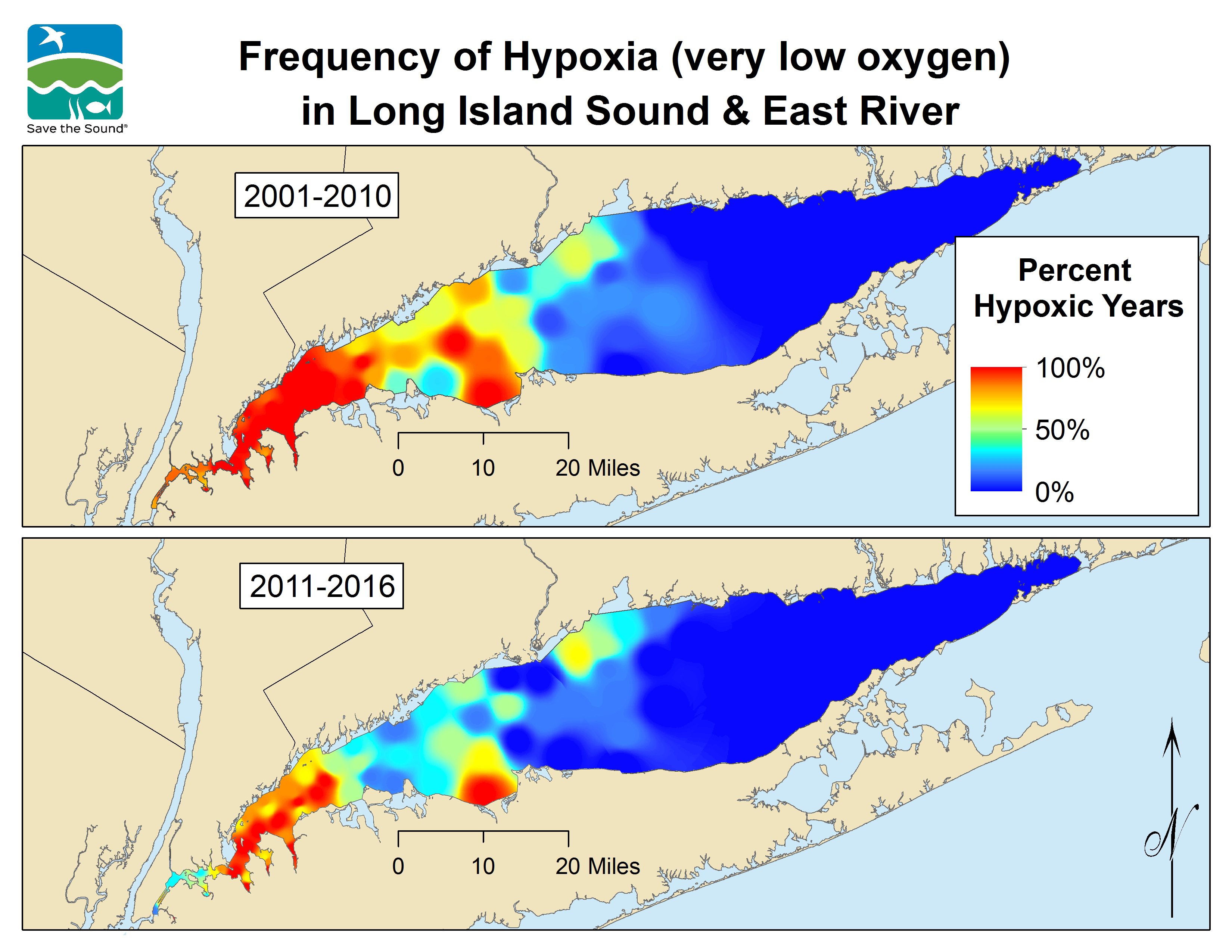
What’s Next?
- The hypoxic dead zone in Long Island Sound is now smaller, but still there, stretching from the East River past the coasts of Westchester and Nassau County in the hot summer months.
- New York City remains one of the top contributors of nitrogen to the Sound, contributing 18% of the nitrogen pollution that is degrading water quality in Long Island Sound.
- Six East River wastewater treatment plants account for 98% of the city’s nitrogen load to the Sound.
- EPA’s 2015 LIS Nitrogen Reduction Strategy called on New York to further reduce nitrogen from wastewater treatment plants in the western end of the Sound, based on assessments of conditions in the Sound. NYC should develop new nitrogen reduction targets in accordance with the EPA strategy.
- Save the Sound calls on New York City to increase its nitrogen reduction at the four recently upgraded plants, committing to a 70% reduction starting in 2018.
- If additional nitrogen reductions are needed, upgrading the Newtown Creek wastewater treatment plant to include nitrogen removal should be evaluated.
- NYC communities need to be engaged in projects designed to reduce local pollution sources and restore natural habitats, including water quality monitoring that involves and informs residents.
Save the Sound thanks EPA, the Long Island Sound Study, NYSDEC, CTDEEP, NEIWPCC IEC, and NYCDEP for their ongoing research, monitoring, and investments in wastewater infrastructure and other initiatives that restore and protect Long Island Sound and the East River for future generations.
Improving water quality in Long Island Sound, reducing the area of hypoxia, and providing habitats supportive of a diverse and vibrant community of sea life require a continuing commitment to reduce nitrogen inputs to the Sound. Working in partnership with all the stakeholders to bring about the needed reductions is a top priority for Save the Sound and our Long Island Soundkeeper.
